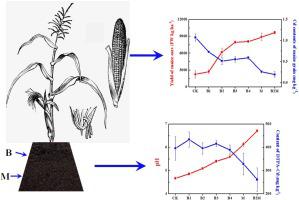当前位置:
X-MOL 学术
›
Agric. Ecosyst. Environ.
›
论文详情
Our official English website, www.x-mol.net, welcomes your feedback! (Note: you will need to create a separate account there.)
Combined biochar and soda residues increases maize yields and decreases grain Cd/Pb in a highly Cd/Pb-polluted acid Udults soil
Agriculture, Ecosystems & Environment ( IF 6.6 ) Pub Date : 2021-02-01 , DOI: 10.1016/j.agee.2020.107198 Lan Wei , Yufen Huang , Lianxi Huang , Qing Huang , Yanliang Li , Xiang Li , Shaohai Yang , Chuanping Liu , Zhongzhen Liu
Agriculture, Ecosystems & Environment ( IF 6.6 ) Pub Date : 2021-02-01 , DOI: 10.1016/j.agee.2020.107198 Lan Wei , Yufen Huang , Lianxi Huang , Qing Huang , Yanliang Li , Xiang Li , Shaohai Yang , Chuanping Liu , Zhongzhen Liu

|
Abstract Excessive heavy metal (HM) in soil limit crop yields and reduce quality of crops and soil. In this study, a 3-year field experiment was conducted to verify the effects of different amendment treatments on the accumulation and distribution of cadmium/lead (Cd/Pb) on maize aboveground parts and the availability of Cd/Pb in Udults soil. The treatments were CK, biochar at 5, 10, 20, 30 t ha−1 (B1–B4), soda residues at 3 t ha−1 (M) and biochar & soda residues (10 t ha−1 + 3 t ha−1; B2M). The results show that the greater the applied biochar dose, the longer lasting the mediating effect; however, the B2M treatment was the most effective and had the longest-lasting effects. Compared to CK, the B2M treatment significantly increased soil pH and total organic carbon levels by 0.68–1.44 pH units and 16.2 %–30.3 %, respectively, and reduced available Cd/Pb by 52.4 %–68.6 % and 28.3 %–40.8 %, respectively. Additionally, B2M also increased the maize grain yield by 7985.2–10,728.9 kg ha−1 and decreased the Cd/Pb contents of maize grains by 0.16–0.21 mg kg−1 (Cd) and 0.05–0.51 mg kg−1 (Pb) over the 3-year period. The Cd/Pb contents in maize grain were lower than the feed additive standard (GB 13078−2017), indicating that this product can be used as animal feed. Soil pH was the most important factor to control Cd/Pb accumulation, while the Cd was also influenced by biochar physicochemical properties such as specific surface area, aromatic structures and oxygen-containing functional groups. A cost analysis for this field experiment revealed that applying combined biochar and soda residues to polluted soil had an economic benefit whereas the application of biochar alone did not.
中文翻译:

在高度 Cd/Pb 污染的酸性 Udults 土壤中,结合使用生物炭和苏打残留物可提高玉米产量并降低谷物 Cd/Pb
摘要 土壤中过量的重金属(HM)限制了作物产量,降低了作物和土壤的质量。本研究进行了为期 3 年的田间试验,以验证不同改良剂处理对玉米地上部分镉/铅 (Cd/Pb) 的积累和分布以及 Udults 土壤中 Cd/Pb 有效性的影响。处理为 CK,生物炭在 5、10、20、30 t ha−1 (B1–B4),苏打残留在 3 t ha−1 (M) 和生物炭和苏打残留(10 t ha−1 + 3 t ha -1;B2M)。结果表明,生物炭用量越大,中介作用持续时间越长;然而,B2M 治疗是最有效且持续时间最长的。与 CK 相比,B2M 处理显着提高了土壤 pH 值和总有机碳水平,分别提高了 0.68-1.44 个 pH 单位和 16.2%-30.3%,并分别减少了 52.4 %–68.6 % 和 28.3 %–40.8 % 的可用 Cd/Pb。此外,B2M 还使玉米籽粒产量增加了 7985.2–10,728.9 kg ha-1,并使玉米籽粒的 Cd/Pb 含量降低了 0.16–0.21 mg kg-1 (Cd) 和 0.05–0.51 mg kg-1 (Pb) 3 年期间。玉米籽粒中Cd/Pb含量低于饲料添加剂标准(GB 13078-2017),表明该产品可用作动物饲料。土壤pH值是控制Cd/Pb积累的最重要因素,而Cd还受比表面积、芳香结构和含氧官能团等生物炭理化性质的影响。该田间试验的成本分析表明,将生物炭和苏打残留物联合应用于污染土壤具有经济效益,而单独使用生物炭则没有。
更新日期:2021-02-01
中文翻译:

在高度 Cd/Pb 污染的酸性 Udults 土壤中,结合使用生物炭和苏打残留物可提高玉米产量并降低谷物 Cd/Pb
摘要 土壤中过量的重金属(HM)限制了作物产量,降低了作物和土壤的质量。本研究进行了为期 3 年的田间试验,以验证不同改良剂处理对玉米地上部分镉/铅 (Cd/Pb) 的积累和分布以及 Udults 土壤中 Cd/Pb 有效性的影响。处理为 CK,生物炭在 5、10、20、30 t ha−1 (B1–B4),苏打残留在 3 t ha−1 (M) 和生物炭和苏打残留(10 t ha−1 + 3 t ha -1;B2M)。结果表明,生物炭用量越大,中介作用持续时间越长;然而,B2M 治疗是最有效且持续时间最长的。与 CK 相比,B2M 处理显着提高了土壤 pH 值和总有机碳水平,分别提高了 0.68-1.44 个 pH 单位和 16.2%-30.3%,并分别减少了 52.4 %–68.6 % 和 28.3 %–40.8 % 的可用 Cd/Pb。此外,B2M 还使玉米籽粒产量增加了 7985.2–10,728.9 kg ha-1,并使玉米籽粒的 Cd/Pb 含量降低了 0.16–0.21 mg kg-1 (Cd) 和 0.05–0.51 mg kg-1 (Pb) 3 年期间。玉米籽粒中Cd/Pb含量低于饲料添加剂标准(GB 13078-2017),表明该产品可用作动物饲料。土壤pH值是控制Cd/Pb积累的最重要因素,而Cd还受比表面积、芳香结构和含氧官能团等生物炭理化性质的影响。该田间试验的成本分析表明,将生物炭和苏打残留物联合应用于污染土壤具有经济效益,而单独使用生物炭则没有。



























 京公网安备 11010802027423号
京公网安备 11010802027423号